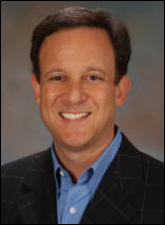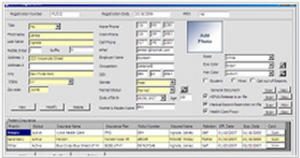HIStalk Practice Interviews Mark Brown
Mark Brown, MD is an ophthalmologist with Vision Partners at Providence Park Hospital, with offices in Daphne and Mobile, AL and Biloxi, MS.
Give me some background on your practice.
We are a group of eight doctors, six ophthalmologists and two optometrists. We founded our practice eight years ago. A smaller core of us was on faculty at the local university and basically things were very restricted in terms of our desire to go more electronic and high-tech. And is often the case with universities, they’ve got their committees etc., and we just didn’t get to do what we wanted to do with it.
Ophthalmology in general is probably one of the more techie kind of subspecialties, and so the entire department left in 2000 — staff, doctors, clerks, everybody in the department. We basically created our own office called Vision Partners. Most of the doctors are fellowship trained and experts in their field. We built an office on a different hospital campus that was built to be paperless.
We had a kind of luxury because we decided when we were going to leave and they didn’t fire us. We had a year to plan and that was instrumental for a number of reasons. We had never done what we were about to do and we needed to choose practice management software and electronic medical records and build a building. We’d never done any of this. We were just kind of flying by the seat of our pants.
I spent the better part of nine months really looking at practice management software and medical records software. We built our building to be very much wired from a networking and computer perspective, and paperless from a perspective of no storage facility in the office at all. Every square foot we wanted to be productive, so we didn’t want to have 2,000 square feet of storage for charts. Over the past couple years, we’ve added on doctors. There were four or five of us when we started; there are eight now.
We have three offices. Our main office is in Mobile, Alabama. We’ve got an office downtown and an office in what’s considered across the bay in Eastern Shore. Basically, we rotate patients in various areas. It’s not quite as bad as New York, but patients desire to stay within two square blocks of their house and don’t want to go anywhere. That’s particularly true for the patients across the bay. Eastern Shore is the city that has been really written up in the news as a top retirement city in the United States. Those patients really look down their nose at coming over to Mobile for anything, so you have to provide services over there.
There was also an issue of how to have everything connected with charts going back and forth. That would be something we would never, never have been able to have done with paper charts. One of my biggest pet peeves at the university and why we wanted to have electronic medical records was my boss, who is now my partner, would notoriously take charts and put them in the back of his Ford Explorer, never to be seen again. I mean, the patient would come in and we have no idea why they were there. You’ve got no chart. The chart’s missing.
Then you have all of these human issues; people unable to follow the alphabet. They just can’t file charts correctly either numerically or alpha, and so the chart is misfiled. It’s there somewhere, but no one knows where it is. Or, the typical scenario is that it goes from surgery to billing to a doctor and it’s always en route from one place to another. You add into the wrinkle of, “Oh my God, it could be in a different office twenty minutes away.” It was just never going to work. We needed the digital copy.
Tell me what kind of technology are you using.
We use about four programs to do everything. I’ll tell you the history, briefly. About nine years ago when I looked for an integrated solution, an integrated practice management/medical record — the whole nine yards — didn’t exist. When one company did well on one, it didn’t do well on the other. The people that had practice management software really had crappy EMRs and I don’t think that’s changed.
I’ve lectured at the New Orleans Academy and I don’t think there’s a product, at least in ophthalmology, where you can get the best of both worlds. So we chose Medical Manager as a practice management software. At the time, they had the claim to fame of having set up a lot of practices and they had widespread customization available. I don’t particularly care for the company — Sage. There are enough freelance programmers out there that could do things if you wanted to be done.
We deployed Medical Manager on a Windows-based system and then we chose SRS medical records. We tied them together with a custom interface so that when a chart would be created in Medical Manager, they would appear in the medical records software automatically and all the demographics would come over on the schedule, the insurance, all of the details. That was important because one of the things we wanted to get with an EMR was not re-inventing the wheel every time with rewriting the patient’s Social Security number and insurance number on every form when we book a surgery or on a consent form or whatever. Those are what they describe as ‘mergeable.’ They come over, and then if you create a Word document, you can have those numbers drop into it automatically.
Two years ago, we stopped liking the clearinghouse Medical Manager had and we went to a product called Practice Insight, which enables us to track our claims and divvy up tasks based on rejected claims in a very systematic way that we never could do with Medical Manager. We initially went with a coding software that was part of Medical Manager, where you filled in the circle like you do on a standardized test.
Then two years ago we moved to a product called White Plume, which interfaces beautifully with SRS. We click the tab, the form comes up electronically, we tick off the buttons that we want. We can add the modifiers, we can see the patient’s insurance right there. We can do really sophisticated things with macros, so we can bundle an ICD-9 and a CPT code all at once. Our office exam rooms all have a computer and we can leverage the system very well. We do all the billing in the room and keep track of what needs to be done, without wasting paper for that matter, or losing charts.
Does White Plume interface with everything? Is it just for the charge ticket or is there a clinical component to it as well?
It’s an electronic charge ticket. When an appointment gets made in Medical Manager, it goes off two different ways. You get a charge ticket created in White Plume and you get an appointment created in SRS. So as soon as I walk into the patient’s room, I’ve got my schedule up on SRS of the patients I’m seeing today and I can sort it by name or by time or whatever I want. Then I launch the bill ticket just by clicking on one of the tabs in SRS. Each of the doctors has their own superbill and it’s seamless for the doctor.
I think that’s the whole thing — I wanted a system that wasn’t going to slow anyone down. Dr. Rich, the guy who was my boss and my partner, he’s at a real high volume. So when I was looking at these systems, he had a low tolerance for anything that was going cause him to see two less patients a day; that was inadequate. As for both the SRS and for the White Plume, it had to be at least as efficient as paper, if not more. So both of those systems had that criteria for us.
You mentioned difficulty finding an EHR that would work well with ophthalmology. What is it about SRS that worked better than some of the other ones out there?
I think the wish would be that you could have a system that doesn’t slow you down. Except that all of the systems out there slow you down. You look at the patient and you say, “Okay, you have a diagnosis of a corneal abrasion.” So I’m going to take my piece of paper through SRS or a paper chart, and I’m going to go to my exam form and I’m going to go to my form and mark corneal abrasion. That takes a microsecond, whereas so many other systems there are these drop-downs where you kind of have to go to the right section of the exam, then you choose anterior segment; and it’s in a series.
It’s a philosophy thing, of grouping or splitting, and so for it to work, you’ve got to split. So you choose anterior segment — that’s the front part of the eye — and then you choose cornea. There are four million things that could be wrong with a cornea and you’ve got to choose whichever one best fits. It’s all about clicks today and it’s one of my biggest gripes when I call up vendors and I say I don’t have any problem with your software — you missed the boat here when they do something that requires five clicks that could be done in one. I went through this with White Plume, asking why do I have to click ‘close’ and ‘save and close’? Why can’t I just click one button to save it all? And they’re like, ‘Well, every click matters.’
I’m under constant fire from the insurance companies for my reimbursements. Blue Cross just announced a 20% fee cut. I can’t make up 20% in my volume and it turns out that my employees don’t want a 20% pay cut. I’m not sure why.
And neither do you.
Yeah, and neither do I, and that’s a problem. It’s a huge problem because every click and everything that slows me down is not good. So I think the other thing about [our selection of SRS] is the reality that paper exists. I mean, let’s not deny this. The fact is, charts are going to come over from other offices that are paper. I looked at one of the companies, a very large company, that had an EMR and a practice management component together and I said, ‘Well, here’s this fax. Put it into your system.’ You know there’s like nine steps? They had to scan it, they had to name it, they had to put it in its place. On a day-to-day basis, there are just too many faxes to deal with that. It would just never be realistic. All of the medical clearance that we get from other medical offices are all paper. Hospitals all work with paper.
You know I’m not saying in ten years or fifteen years it might not be different. I guess we’ll have to wait and see, but I’d say for a long period of time, the standard is going to be an 8½ x 11 sheet of paper. So many of these other practice management software had no way to really bridge the gap between paper and digitized, but what every one of us liked about SRS was that it didn’t require us to change what we do. We still could write on paper and we’d have the PDFs, my built-in system. I don’t have to worry about the company going out of business. Everything’s a PDF. There’s nothing proprietary about it.
And, it’s intuitive. The first training session we had, I took a group of 20 people from the university. Generally, university employees are like government employees, you know? They’re just not the most motivated people. These people, they didn’t have computers at the University. I sat them down and they had never used a mouse, aside from people that had a computer at home. I mean, people were looking at me like, what was I thinking? It was a thirty-minute training session. I still haven’t read the manual on SRS. I’m sure there are other features that I could be using that I’m not. The reality is that we can hire new staff and say this is what it is and they can just kind of look at it and figure it out. It’s just intuitive, and that’s not the case for most software.
Has the passage of the ARRA legislation changed your focus at all in terms of your technology adoption and usage?
Well, it annoys me. I don’t remember signing up to be a government employee when I went to medical school. I’m very cynical about the whole premise that it’s going to save money. I see money being spent, but I don’t see money being saved. I think that capitalism should take over. It reminds me of when the HIPAA rule came out two or three years ago. We’re like, ‘Oh, I’ve got to have this piece of paper that I have my staff or my patients sign that I’m not going to share your information.” Well, I don’t know, the people in Washington decided that was important and so then I had to implement it.
I had to pay for those papers to be created and printed and passed out. I think that the first time that a doctor’s office sells their patient information, I bet that patient doesn’t go back to them. I just think well, I don’t get reimbursed to do that. It just seems like a common sense kind of thing, or common courtesy, or free market would take care of itself. So when you go and impose this, “This is how we want you to document your medical records.” Well, who is that saving money? Because it’s not that I’m going to get more money from Blue Cross or Medicare. I might get a less of a penalty, but it doesn’t translate into making my office better. It just serves their need of that’s what they want to do.
But let’s say we all did that. How does it really save anyone any money having everything — I mean, we’ve spent how many billions of dollars doing it now? Ten years later, everyone’s got an EMR. Has it saved the system money? I mean, I’m not really convinced that it has. With the exception, perhaps, of redundancy of ordering tests that have already been ordered. There are lots of other ways to deal with that. They could just put a penalty on you to say, you know what? If you order a test that another doctor ordered and you’ve repeated it because you were too lazy to look up the result, then you know, you get fined. That would prevent people from ordering tests that aren’t necessary or have already been ordered.
I think the government has a really bad track record of following through on the payments. I think the physician practice in this scenario is kind of being forced to take on a liability or a risk without really any guarantee of payment. I don’t think people that I’ve talked to have gotten their PQRI payments. The reason we went with an EMR was: a) to save money, and a) to be more productive. The ones that are qualifying to meet those criterion are going to slow me down, and so I’m not excited about it because if I have a lost productivity of seeing a couple patients less a day, it’s not worth it.
So you are saying you may not change anything and just forego the incentives?
That’s exactly what I’m saying, and I’m mad about it because I have an EMR and I have a system that I believe meets the realistic criterion. I don’t think that the people that are coming up with the criterion are in practice. Patients can easily get a copy of their medical record; it’s portable; I can have multiple copies of it. It’s a huge step up from the paper record, and yet it doesn’t change the way Mark Brown wants to be an eye doctor.
And by the way, patients, I don’t think, really care for the idea of my spending my consultative time staring at the computer ticking off boxes rather than making eye contact with a patient where I can do with a clipboard and a piece of paper. You can’t talk into the screen and have the patients hear you, and not to mention it’s rude. So now I’m looking at the patient and having a conversation, but normally I could be filling out a form at the same time, but now I’ve got to turn and document things after. Well, I guess I could hire a scribe to enter all that. That’s going to just be a drain of another salary per doctor. There are all these things that you could do to justify it, but the practice keeps absorbing the expenses. It’s not like I get reimbursed any more money. The rules that are imposed by the government only decrease our productivity.
You said one of your initial goals was to save money. Has that occurred?
Absolutely. We fired two people. I don’t want to get rid of every human being. I want to support the local economy, but we got rid of people that prepared the charts every day. What a ridiculous job. Day in and day out you go and you look for the chart and you put a blank piece of paper in, form the chart for the exam, sort and organize the chart. That was an entire salary at university.
The other is the charge entry. It’s all automated — it’s ready to go out the door. I think the biggest thing is the sanity factor. What we all like is the fact that the chart can be open. What typically happens in a practice is Mrs. Smith calls in with a complaint, the technician answers the phone, and now they’ve got to get the chart. Think about how much time that takes. They’ve got to find the chart and then they’ve got to review it. Then they’ve got to go pass the chart to the doctor and they’ve got to review it. Whereas with the SRS here, they could pull up the chart, they can either buzz me in my office or they can send me a message attached to the chart and I can just look at it. And, the chart can be open in two places at the same time. That can’t happen in a paper system.
As you know, overall EMR adoption is still pretty low. Why do you think that is the case? Why are so many of your colleagues still so resistant?
Initially, it is the upfront expense. Then you look at the past year and ask what the government is going to do. They are uncertain if these standards are really set. Are the standards going to change? What if I buy a system that’s not upgradeable? This isn’t done as a rebate system from what I understand, so I think potentially you’re talking about not getting the money that you want or think you’re going to get. I think that you’ve got an economy that’s not good and you’re asking the doctors to put up the money to do it. It’s one thing if you were already moving or built an office, but if you were going to outfit an entire office, it’s expensive. And, it’s a tremendous loss of production while you’re going through that transition.
If you look at the EMRs that are out there [versus SRS] and you say, ‘Well, OK, we have 100,000 charts.’ [For us, the transition was 100% transparent to the doctors.] We hired a bunch of college kids to start scanning the files and we did it for months. But, what does the average office do? How long does it take to roll into a new system and what do you do with all the old records in that time? You have no access to the old data, and so you’ve got a paper chart that you’re reviewing, and then you’re starting a new system. [With a CCHIT, we would be basically doubling our work as we reviewed patient’s notes on paper and then started their CCHIT chart.] I can tell you that during that first two years I bet our production [would have] dropped 30-40% [compared to our old paper system] because we [would have been] basically doubling our work. No one’s going to want to do that.
The other issue is so many of these systems really are complicated and require an IT person. You get to have an EMR, then you get to hire someone at a $50,000 a year salary to babysit the computers because Windows needs updates and the network goes down. All of those things are reasons why people didn’t sign up for EMR.
Any other general impressions on the industry you’d like to share?
I think in general, SRS seems to be more unique in understanding what doctors do. Medical Manager is up to version 10 or so, so they’ve had enough years of feedback to be told. Other companies that we’ve dealt with, we say, well this is what we want to do, and they’re like, “Well, oh, we hadn’t thought of that” or “the programmer didn’t design it that way”. I can’t speak to other products, but it’s the same thing over and over again with the companies and the programmers. There’s a disconnect between how the practice of medicine is performed. For some reason, it is not present in SRS. They seem more responsive and more in-tune.
I think the other companies that I’ve worked with, White Plume and Practice Insight, are responsive to my suggestions, which is good because of course, I always like my suggestions. But I’m often amazed by products, asking, “What were you thinking when you designed it that way?” I kind of hit my head against a wall sometimes. It’s just an example of someone who actually is designing from a computer perspective, and not from an IT perspective. I don’t know if it’s a matter of the industry needing more practicing physicians on their consultative boards and things like that.
You can look at me as the “doctor not for the $44,000.”














The article about Pediatric Associates in CA has a nugget with a potentially outsized impact: the implication that VFC vaccines…